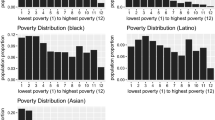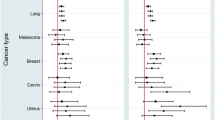Abstract
This cumulative incidence study was accomplished among adults in Upstate New York metropolitan areas (Buffalo, Rochester, Syracuse and Albany—1979–1986). It used a new ecological socioeconomic status measure—near poverty status (i.e., below 200% of the federally established poverty criterion, including the poor and near poor)-and observed its association with site-specific cancer incidence (lung, stomach, cervix uteri, prostate, colon, rectum and breast). Findings were: 1) near poverty status is directly associated with each cancer site's incidence and the strength of the associations are similar among blacks and whites for each one and 2) the prevalence of exposure, of living in high near impoverishment areas, is nearly seven-fold greater among blacks; prevalence ratio [PR]=6.74 (95% confidence interval [CI]:5.07,8.99).
Similar content being viewed by others
References
Gorey KM.The Association of Socioeconomic Inequality With Cancer Incidence: An Explanation For Racial Group Cancer Differentials. Doctoral dissertation, State University of New York at Buffalo, 1994, pp 162–167.
Gorey KM, Vena JE. Cancer differentials among United States blacks and whites: quantitative estimates of socioeconomic-related risks.J Natl Med Assoc 1994; 86:209–215.
Krieger N. Social class and the black/white crossover in the age-specific incidence of breast cancer: a study linking census-derived data to population based registry records.Am J Epidemiol 1990; 131:804–814.
Krieger, N. Overcoming the absence of socioeconomic data in medical records: validation and application of a census-based methodology.Am J Public Health 1992; 82:703–710.
Pappas G. Elucidating the relationship between race, socioeconomic status, and health.Am J Public Health 1994; 84:892–893.
Schwartz S. The fallacy of the ecological fallacy: the potential misuse of a concept and the consequences.Am J Public Health 1994; 84:819–824.
Susser M. The logic in ecological. I. The logic of analysis.Am J Public Health 1994; 84: 825–829.
Rodgers GB. Income and inequality as determinants of mortality: an international cross-sectional analysis.Pop Studies 1979; 33:343–351.
Wilkinson RG. Class mortality differentials, income distribution and trends in poverty 1921–1981.J Soc Policy 1989; 18:307–335.
Wilkinson RG. Income distribution and life expectancy.Br Med J 1992; 304:165–168.
Wilkinson RG. Income distribution and mortality: a ‘natural’ experiment.Sociol Health Illness 1990: 12:391–412.
Wilkinson RG. National mortality rates: the impact of inequality.Am J Public Health 1992; 82: 1082–1084.
McWhorter WP, Schatzin AG, Horm JW, Brown CC. Contribution of socioeconomic status to black/white differences in cancer incidence.Cancer 1989; 63:982–987.
Greenberg ER, Colton T, Bagne C. Measurement of cancer incidence in the United States: sources and use of data.J Natl Cancer Inst 1982; 68:743–750.
New York State Department of Health:New York State Cancer Registry. Albany, NY: Author, 1990.
Wilson S, Prior P, Woodman CBJ. Use of cancer surveillance data for comparative analyses.J Public Health Med 1992; 14:1516.
U.S. Bureau of the Census.1990 Census of Population and Housing—Census Tracts—New York State. Summary Tape File (STF) 3A. Washington, DC: U.S. Government Printing Office 1992.
U.S. Bureau of the Census.1980 Census of Population and Housing—Census Tracts—Albany, Buffalo, Rochester and Syracuse, NY, Standard Metropolitan Statistical Areas (PHC80-2-61,106,306 and 346). Washington, DC: U.S. Government Printing Office, 1983.
Howe HL. Geocoding NY State cancer registry.Am J Public Health 1986; 76:1459–1460.
Miettinen OS, Estimability and estimation in case-referent studies.Am J Epidemiol 1976; 103:226–235.
Fein DJ. Racial and ethnic differences in U.S. census omission rates.Demography 1990; 27: 285–302.
Wolter KM. Accounting for America's uncounted and miscounted.Science 1991; 253:12–15.
Carlo GL, Mettlin CJ. Cancer incidence and trihalomethane concentrations in a public drinking water system.Am J Public Health 1980; 70:523–525.
Author information
Authors and Affiliations
Additional information
This work was supported by Grant No. CA09051-17 from the National Cancer Institute. The authors gratefully acknowledge the assistance provided by Drs. Nancy Krieger (Kaiser Foundation Research Institute, Oakland, CA), Richard G. Wilkinson (University of Sussex at Brighton, England), Maria A. Zielezny (Department of Social and Preventive Medicine, Univeristy at Buffalo) and Arthur M. Michalek (Education and Epidemiology Departments, Roswell Park Cancer Institute, Buffalo, NY) who critically reviewed earlier draft versions of this manuscript. The administrative assistance provided by the director of New York State's (NYS) Cancer Registry, Dr. Mark S. Baptiste (Bureau of Cancer Epidemiology, NYS Department of Health), is also gratefully acknowledged.
Rights and permissions
About this article
Cite this article
Gorey, K.M., Vena, J.E. The association of near poverty status with cancer incidence among black and white adults. J Community Health 20, 359–366 (1995). https://doi.org/10.1007/BF02283060
Issue Date:
DOI: https://doi.org/10.1007/BF02283060




